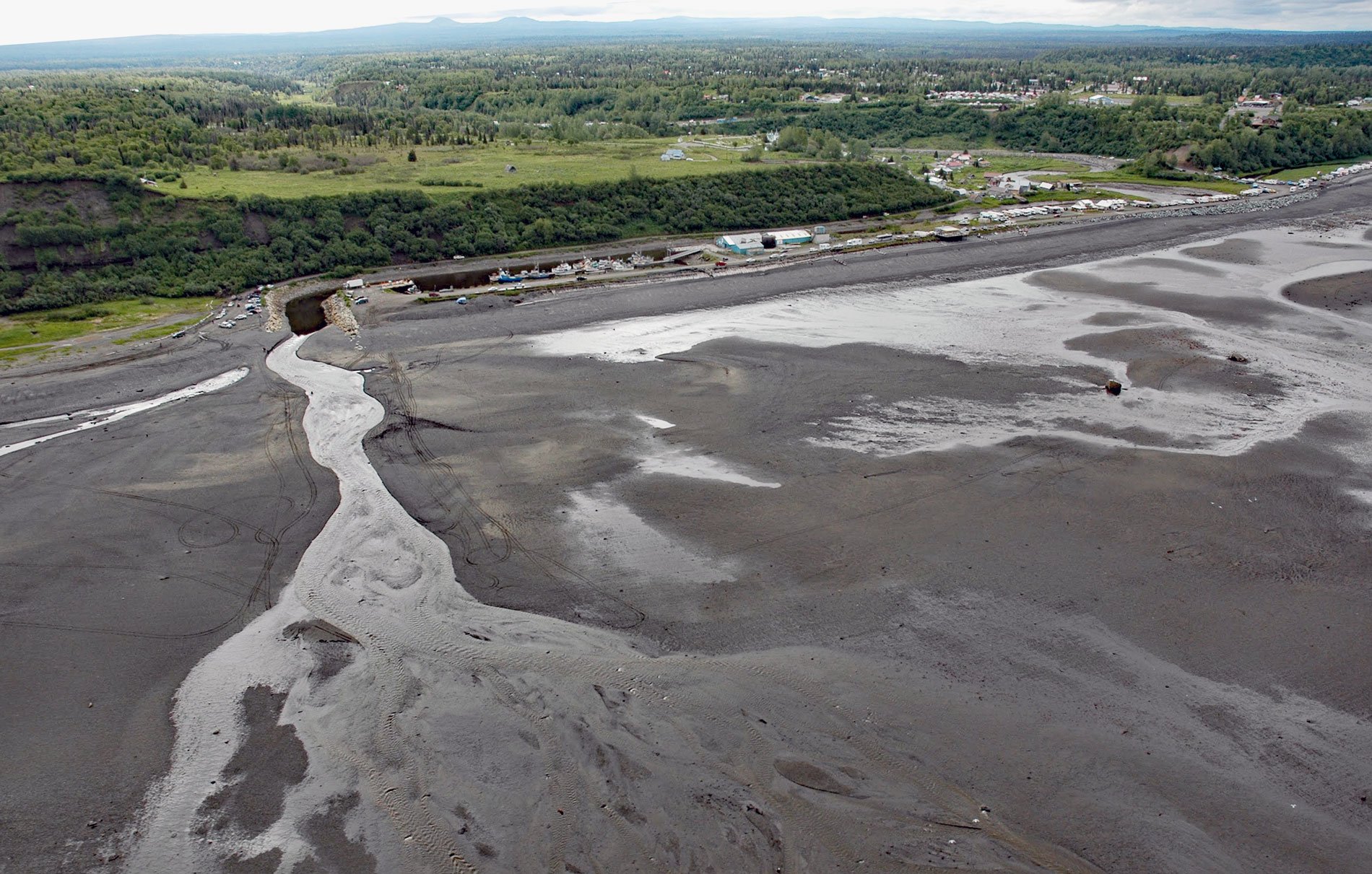Ninilchik is a community at Cape Ninilchik at the mouth of the Ninilchik River on the Kenai Peninsula, on the eastern shore of Cook Inlet, about 99 miles (160 km) southwest of Anchorage and 30 miles (48 km) north-northwest of Homer, Alaska. Road access to the village is from the Sterling Highway. Ninilchik was originally a settlement formed around fox farming and salmon fishing. Before the arrival of Europeans, Ninilchik was a Dena’ina Athabascan village used for hunting and fishing. The name Ninilchik probably derives from ‘Niqnilchint’, a Dena’ina Athabascan word meaning ‘lodge is built place’. The Alaska Native people of Ninilchik are descended from Russian, Aleut, Alutiiq, and Dena’ina people. The Ninilchik River flows southwest and roughly parallel to Cook Inlet for about 18 miles (29 km) from a watershed divide about 5 miles (8 km) southeast of Calm Gulch and 5 miles (8 km) southwest of Tustumena Lake. The river turns sharply northwest near Ninilchik and flows 2.9 miles (4.7 km) to Cook Inlet at the Ninilchik State Recreation Area. A small boat harbor, used mainly by fishing boats, is dredged out of the river mouth near the town. The river is a popular fishing location for Chinook salmon in May and June, coho salmon and Dolly Varden in late summer and early fall, and steelhead in late fall. The climate is changing relatively quickly in high-latitude regions like Alaska, where the mean annual air temperature has increased significantly over the past 50 years. The effects of increasing river water temperature on Pacific salmon and their food are being studied but will certainly alter the spawning and rearing habitat of Ninilchik River salmon populations.
In 1787 or 1788, Russian fur traders with the Shelikhov-Golikov Company established a trading post called Aleksandrovskaia at Seldovia, and at about the same time other fur traders with the Lebedev-Lastochkin Company established a trading post called Pavlovskaia at the mouth of the Kenai River. The latter group also started an artel at the mouth of the Kasilof River in the early 1800s. In 1847, the first Europeans arrived at Ninilchik who were Russian colonists that moved from Kodiak Island and permanently settled at the existing Dena’ina village. They were Grigorii Kvasnikov, his Russian-Alutiiq wife Mavra Rastorguev, and their children. They were soon joined by the Oskolkoff family. Their dialect of Russian became the primary non-native language spoken in the community and is now considered to be a rare dialect of Russian that survived for about 100 years in almost total isolation from mainstream Russian. In the 1940s, a number of American homesteaders began to live in the area, and in 1949, the Berman Packing Company began salmon canning operations at the mouth of the Ninilchik River. In 1950, the Sterling Highway was completed and connected the town to the state road network. The original village was located at the mouth of the Ninilchik River where a small harbor was constructed. The name Ninilchik is used today to refer to the original village on the river as well as the extensive surrounding community along the highway between the Ninilchik River and Deep Creek. Today Ninilchik is a tourist destination, popular for salmon and halibut fishing, and for Pacific razor clams that are dug from the beaches during extremely low tides.
Pacific razor clams are found in stable, sandy, surf-swept beaches of the open coast and some coastal bays such as Cook Inlet. Populations are found in the subtidal and very low intertidal areas of the nearshore ocean. The intertidal populations are available to clam diggers at the lowest tides of the year. Although razor clams are capable of vertical movement through the sand and can dig up to a foot in a minute and have been recorded at depths more than four feet in the sand. Clams are found near the sand surface during and shortly after tidal submersion. They spend the interval between tides deeper in the sand to escape predation. A razor clam reaches maturity in the second year of life. Males and females primarily spawn in the spring and summer when the water temperature is warmest. Eggs and sperm are released into the water where fertilization occurs. The fertilized eggs develop into free-swimming larvae which, depending upon water temperature, develop into juvenile clams in 5-16 weeks. As the larvae begin to resemble adults, shells develop and they settle to the bottom where they dig into the sand. Inshore ocean currents, water temperature, and climatic conditions all have a strong influence on the number of larvae reaching the beach and their survival. Approximately 95 percent of the juveniles reaching the beach die of natural causes before reaching maturity. Juveniles are usually found in the first few inches of the sand and as they grow will dig deeper into the sand. Growth is slow during the fall and winter but is incredibly rapid during the spring and summer when the water warms and plankton food supply increases. Pacific razor clams are highly desirable shellfish and are collected by both commercial and recreational diggers. Razor clams, like other shellfish, may accumulate dangerous levels of the marine toxin domoic acid. Domoic acid is a neurotoxin that causes amnesic shellfish poisoning. It is produced by diatoms, a single cell alga that is consumed by filter-feeding shellfish, and plankton-feeding fishes such as sardines and anchovies. Poisoning may results when predators such as sea lions, sea otters, whales, humans, birds, eat contaminated animals. In 2015, the North American Pacific Northwest coast was heavily impacted by a toxic algal bloom. Elevated levels of domoic acid were measured in stranded marine mammals, prompting the closure of crab fisheries and razor clam beaches. Read more here and here. Explore more of Ninilchik here:

